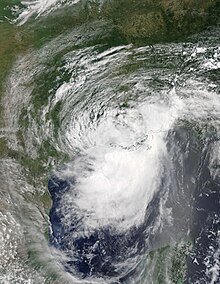
Back Ouragan Barry (2019) French Barry hurrikán (2019) Hungarian Furacão Barry (2019) Portuguese Hurricane Barry (2019) SIMPLE Баррі (ураган, 2019) Ukrainian Barry dovuli (2019) Uzbek Bão Barry (2019) Vietnamese 颶風巴瑞 (2019年) Chinese
 Barry shortly after making landfall in Louisiana at peak intensity on July 13 | |
| Meteorological history | |
|---|---|
| Formed | July 11, 2019 |
| Post-tropical | July 15, 2019 |
| Dissipated | July 19, 2019 |
| Category 1 hurricane | |
| 1-minute sustained (SSHWS/NWS) | |
| Highest winds | 75 mph (120 km/h) |
| Lowest pressure | 993 mbar (hPa); 29.32 inHg |
| Overall effects | |
| Fatalities | 3 total |
| Damage | $600 million (2019 USD) |
| Areas affected | Midwestern United States, Gulf Coast of the United States, Arkansas, Oklahoma, Eastern United States, Eastern Canada |
| IBTrACS | |
Part of the 2019 Atlantic hurricane season | |
Hurricane Barry was an asymmetrical Category 1 hurricane that was the wettest tropical cyclone on record in Arkansas and the fourth-wettest in Louisiana. The second tropical or subtropical storm and first hurricane of the 2019 Atlantic hurricane season, Barry originated as a mesoscale convective vortex over southwestern Kansas on July 2. The system eventually emerged into the Gulf of Mexico from the Florida Panhandle on July 10, whereupon the National Hurricane Center (NHC) designated it as a potential tropical cyclone. Early on July 11, the system developed into a tropical depression, and strengthened into a tropical storm later that day. Dry air and wind shear caused most of the convection, or thunderstorms, to be displaced south of the center. Nevertheless, Barry gradually intensified. On July 13, Barry attained its peak intensity as Category 1 hurricane with 1-minute sustained winds of 75 mph (120 km/h) and a minimum central pressure of 993 millibars (29.3 inHg). At 15:00 UTC, Barry made its first landfall at Marsh Island, and another landfall in Intracoastal City, Louisiana, both times as a Category 1 hurricane. Barry quickly weakened after landfall, falling to tropical depression status on July 15. The storm finally degenerated into a remnant low over northern Arkansas on the same day, subsequently opening up into a trough on July 16. The storm's remnants persisted for another few days, while continuing its eastward motion, before being absorbed into another frontal storm to the south of Nova Scotia on July 19.[1]
Barry was one of four hurricanes to strike Louisiana as a Category 1 hurricane in the month of July, the others being Bob in 1979, Danny in 1997, and Cindy in 2005.[2] Numerous tropical storm watches and warnings were issued for Mississippi and Louisiana ahead of the storm. Several states declared state of emergencies ahead of the storm. Though Barry only produced hurricane-force winds in a small area of Louisiana, more than 153,000 customers lost power in the state. As Barry drifted westward over the Gulf of Mexico, storm surge caused widespread coastal flooding in Alabama, Mississippi, and Alabama. The storm's large circulation produced heavy rainfall over a large area, reaching 23.43 in (595 mm) near Ragley, Louisiana, and 16.59 in (421 mm) near Dierks, Arkansas. The latter value was the highest amount of rainfall recorded in Arkansas related to a tropical cyclone. Many roads, including Interstate highways, were flooded. Dozens of water rescues were carried out in Louisiana and Arkansas, where the most significant flooding occurred. In parts of the Northeastern United States and Ontario, Canada, severe thunderstorms from Barry's remnants caused an additional 160,000 power outages and spawned a few weak tornadoes. The storm caused two fatalities: one in Florida from rip currents, and one in Connecticut from fallen trees and wires.[3][4] Damage from Barry was estimated to be about $600 million (2019 USD).
- ^ Cite error: The named reference
WPC reportwas invoked but never defined (see the help page). - ^ Mitchell, Chaffin; Navarro, Adriana (July 14, 2019). "First Hurricane Landfall of the Season Leaves Louisiana, Mississippi waterlogged". Accuweather. Archived from the original on July 15, 2019. Retrieved July 15, 2019.
- ^ Cite error: The named reference
Peoplewas invoked but never defined (see the help page). - ^ Fry, Ethan (July 17, 2019). "Man dies after wires, tree fall on vehicle on Fairfield-Bridgeport line". Connecticut Post. Retrieved September 17, 2021.
© MMXXIII Rich X Search. We shall prevail. All rights reserved. Rich X Search